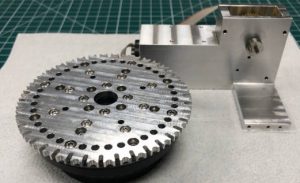
“Researching the effects of microgravity and radiation in on-ground facilities has technical constraints that can add complexity to data interpretation,” said project head and Cranfield PhD student Aqeel Shamsul. “However, in-flight experiments come with their own challenges, often entailing expensive launch missions. These factors are limiting research into the effects of environmental space factors on biological systems. We’re combatting this by designing a cheaper way to conduct biological research in space.”
The lab has a disk with multiple chambers along its edge (see photo) that contain isolated biological samples which can be rotated to face microfluidic inlet and outlet through which food can be supplied or samples extracted. A microscope and a spectrometer are other stations around the disc.
How to turn the disc was one design challenge, for which the team turned to component distributor EMS.
“We originally considered a stepper motor for the BAMMsat system, but EMS showed us that a brushed DC motor would better fit our torque and space requirements,” said Shamsul.
According to EMS, its calculations showed that a 22mm diameter ‘SR’ brushed motor from Faulhaber would get the most performance from the volume and weight allowance available when paired with a planetary gearhead to increase torque and a encoder for fine speed control.
There are 12 motor sizes in the Faulhaber SR family, two of them 22mm in diameter: one 24 mm long and the other (left) 32mm
“The BAMMsat project is a result of impressive collaboration between a number of engineering sectors, incorporating aerospace, biological and mechanical expertise,” said EMS sales manager Dave Walsha. “We recognise that university projects are at the forefront of technology, and EMS endeavours to contribute to these ventures to support the next generation of engineers.”
BAMMsat is not actually going into space.
Instead, it is going to the stratosphere in October with BEXUS – Balloon Experiments for University Students – with the help of the Swedish National Space Agency, German Aerospace Centre and European Space Agency, amongst others.
The balloon mission will allow the BAMMsat control system and payload hardware to be tested in a space-representative environment.
E. coli and C. elegans are candidates for the flying lab – C. elegans is particularly favoured for studying the effect long term space travel will have on the human body, according to EMS, because both humans and C. elegans are eukaryotic organisms and share certain genes and molecular pathways. C. elegans has also been completely sequenced.
EMS was founded in 1985 and is a supplier of precision small DC motors and linear actuators, both making products and distributing those of other companies. It supplies sectors including medical devices, aerospace, defence and military.
The EMS website is here.